#Hystricidae
Text
Uncharismatic Fact of the Day
Although adult crested porcupines aren't anything to mess with, they don't start out that way! Baby porcupines, also known as porcupettes, are born with soft quills. These quills harden over the next several hours, and by the time they're a day old each porcupette is well equipped to defend themself against predators-- though they won't venture out of their den for another week or so.
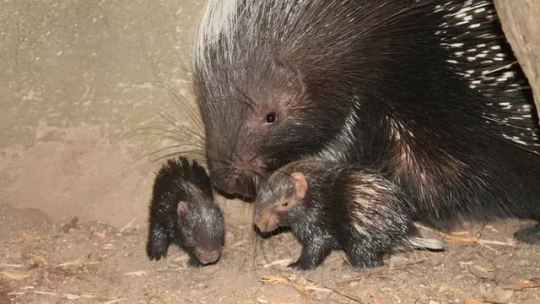
Image: A mother cape porcupine (Hystrix africaeaustralis) along with her two porcupettes, by the London Zoo)
#crested porcupines#Rodentia#Hystricidae#old world porcupines#porcupines#rodents#mammals#uncharismatic facts
174 notes
·
View notes
Text
Are porcupines nocturnal

#Are porcupines nocturnal skin
#Are porcupines nocturnal skin
An unpleasant scent is produced from the skin above the tail in times of stress, and is often seen with quill erection. The use of odor is when the sight and sound have failed. The rattling of quills is aided by the hollow quills at the back end of the porcupine. This behaviour is often paired with body shivering, which is used to further display the dangerous quills. The incisors vibrate against each other, the strike zone shifts back and the cheek teeth clatter. Along with the raising of the quills, porcupines clatter their teeth to warn predators not to approach. This, along with the raising of the sharp quills, deters predators. The dark body and coarse hair of the porcupine are a dark brown/black and when quills are raised, present a white strip down its back mimicking the look of a skunk. A porcupine's markings are black and white. A porcupine's colouring aids in part of its defence as most of the predators are nocturnal and colour blind. These displays are ranked from least to most aggressive. There are four main displays seen in a porcupine which are quill erection, teeth clattering, emitting of odour, and attack. Often, these displays are shown when a porcupine becomes agitated or annoyed. Defense ĭefensive behaviour displays in a porcupine depend on sight, scent, and sound. Porcupines have become a pest in Kenya and are eaten as a delicacy. It is mostly nocturnal, but will sometimes forage for food in the day, eating bark, roots, fruits and berries, as well as farm crops. The African porcupine is not a climber and forages on the ground. The North American porcupine is a herbivore it eats leaves, herbs, twigs, and green plants such as clover. Porcupines have a relatively high longevity and hold the record for being the longest-living rodent, with one individual named Cooper living past 32 years. The New World porcupines evolved their spines independently (through convergent evolution) and are more closely related to several other families of rodents than they are to the Old World porcupines. The two subfamilies of New World porcupines are mostly smaller (although the North American porcupine reaches about 85 cm or 33 in in length and 18 kg or 40 lb), have their quills attached singly rather than grouped in clusters, and are excellent climbers, spending much of their time in trees. The 11 Old World porcupines tend to be fairly large, and have spines grouped in clusters. Old World compared with New World species The two families of porcupines are quite different, and although both belong to the Hystricognathi branch of the vast order Rodentia, they are not closely related. Porcupines vary in size considerably: Rothschild's porcupine of South America weighs less than a kilogram (2.2 lb) the crested porcupine found in Italy, North Africa, and sub-Saharan Africa can grow to well over 27 kg (60 lb). Porcupines' spiny protection resembles that of the unrelated erinaceomorph hedgehogs and Australian monotreme echidnas as well as tenrecidĪ porcupine is any of 58 species of rodents belonging to the families Erethizontidae (genera: Coendou, Erethizon, and Chaetomys) or Hystricidae (genera: Atherurus, Hystrix, and Trichys). Porcupines' colouration consists of various shades of brown, grey and white. Weighing 5–16 kg (12–35 lb), they are rounded, large, and slow, and use an aposematic strategy of defence. In taxonomic terms, they form the family Erethizontidae. They are less strictly nocturnal than their Old World counterparts, and generally smaller. They live in wooded areas and can climb trees, where some species spend their entire lives. The New World porcupines are indigenous to North America and northern South America. In taxonomic terms, they form the family Hystricidae. They are large, terrestrial, and strictly nocturnal. The Old World porcupines live in Italy, Asia (western and southern), and most of Africa. The largest species of porcupine is the third-largest living rodent in the world after the capybara and beaver. Despite this, the two groups are distinct from one another and are not closely related to each other within the Hystricognathi. Both families belong to the infraorder Hystricognathi within the profoundly diverse order Rodentia and display superficially similar coats of rigid or semi-rigid quills which are modified hairs composed of keratin. The term covers two families of animals: the Old World porcupines of family Hystricidae, and the New World porcupines of family Erethizontidae. Porcupines are large rodents with coats of sharp spines, or quills, that protect them against predation. Rodent with a coat of sharp spines PorcupineĬladistically included but traditionally excluded taxa

0 notes
Text
Are porcupines nocturnal

ARE PORCUPINES NOCTURNAL SKIN
The porcupine is another one of these species. For example, many female monkeys and chimpanzees advertise their sexual readiness. There are several animal species where the female initiates mating – known as “ sex role reversal”. The female initiates contact during mating season Exceptions include reproduction and the times they spend caring for their young. Like the males, female porcupines spend most of their days alone. The only time these animals are more vocal is during breeding season, as they will fight (or dance) for the right to mate. This is especially true with males, who spend most of their lives wandering around quietly on their own. Porcupines are solitary animalsįor the most part, porcupines are solitary. So it’s less common to come across a porcupine without quills. In fact, “successor” quills start emerging only a few days after the earlier ones come out. Luckily, the loss of their quills doesn’t leave them unprotected. As mentioned, porcupines don’t shoot their quills, but they do detach fairly easily.Īs a result, it’s quite common to find porcupine quills lying on the ground in the wild. You may not know too much about porcupines, but the chances are that you know about the quills that protect their soft bodies.Īt any given time, a porcupine has up to 30 000 quills covering its body. Lost African porcupine quills are quickly replaced by new ones They are also smaller and more diurnal than their Old World counterparts. They prefer wooded habitats and are apt at climbing trees. The New World porcupines live in North and South America. This group consists of large, nocturnal, land-based animals. The Old World porcupines live in southern Europe, Asia, and across Africa. New World and Old World porcupine habitsĪlthough both the New World and the Old World porcupines boast a similar coat of quills, they are two distinct groups and not as closely related as you would imagine. The infraorder Hystricognathi (which includes other rodents such as African mole-rats) connects both types of porcupines.īut what’s the difference between New World and Old World porcupines? 4. The species’ scientific name depends on whether it belongs to the Old World porcupines of the Hystricidae family or the New World porcupines that are a part of the Erethizontidae family. The porcupine has quite an interesting heritage. A porcupine’s scientific name is Erethizon dorsatum and Hystricidae Although this deviates from their herbivorous diet, it doesn’t change their dietary classification. Interestingly enough, reports show that porcupines may gnaw on carrion and bones. This allows for an effective fermentation to break down the tough food materials. The adapted biological make-up of the porcupine helps with the ingestion of this diet.įor example, the Cape porcupine has a long small intestine and large caecum (which connects the two intestines). Porcupines eat plant matter, including fruits, roots, tubers, bulbs, and bark. Have you ever wondered, “what do African porcupines eat”? Porcupines are herbivores, meaning that they only eat plant material. This means that the slightest unwanted touch from a predator can fix dozens of painful quills into the porcupine’s enemy. Porcupines do not shoot their quills in the way that you would imagine shooting an arrow. But there seems to be a lot of confusion about whether porcupines shoot their quills. These quills keep the rodent safe from predators and can even prevent a pride of lions from taking a porcupine down.
ARE PORCUPINES NOCTURNAL SKIN
The quills are in the skin and muscles of the animal. Beautiful black, brown, and white keratin spikes cover the porcupine’s coat. Do porcupines shoot their quills? Not really!Īrguably the most identifiable characteristic of the porcupine is their quills. You might spot some key differences between porcupines and hedgehogs too. Let’s take a look at a few facts about porcupines for kids and adults to learn more about these spiky animals. Below are some fun facts about the fascinating creatures and a few answers to some earnest questions. These large rodents are the perfect example of a diverse species. Porcupines live all over the world, from the stocky Cape porcupine in South Africa (and across central and southern Africa) to the North American porcupine known as the New World porcupine. However, anyone who has stumbled upon a porcupine quill will know just how prickly these creatures are in reality. Many kids’ stores even stock stuffed toys in the character of porcupines. To some, porcupines may appear to be cute and cuddly. How sharp are you when it comes to porcupine facts? Well, at least one or two of the interesting things in this list will likely surprise you.

0 notes
Text
Genetic Distrust
She wished she had quills
And further fueled distrust
Of the ones
With whom she was related
She wouldn't state
Why she distrusted them so much
Some of her reasons made sense
And some of them were just there
(instinctive)
In her mind, she pictured a porcupine
Not erethizontidae, those run away
No, she pictured hystricidae
The kind that crippled apex predators
Turning lions and tigers into maneaters
She pictured a rodentine amalgam
With the quills of hystricidae
And her relatives as its enemies
As she mused, she envied this creature
It had what she didn't
Still, she distrusted her relatives
Those ones with whom she shared her genetics
For reasons
Reasons that made sense
And ones that didn't
(instinctive)
Still, within, in her imagination,
She pictured a despondent quilled rodentine amalgam
And a lioness and tiger in the distance
In reality, she'd never let them embrace her
No, she kept them at a distance
That amalgam's quills could cripple them both
(perhaps, at one point, they nicked her with their claws?)
She'd rather burn herself alive
Self-immolation would hurt a lot less
Than get close to them again
Such is her existence
And she's accepted it
#animal motifs#some reality subtext#syngenesephobia#written 9/25/2022#written on the fly#porcupine quills#such is existence#instinctive distrust#dysfunctional family#longish poem
0 notes
Photo
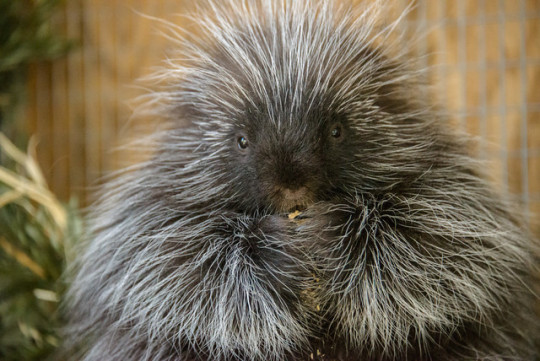
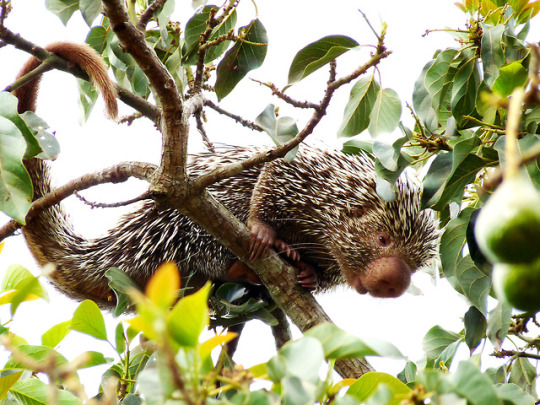



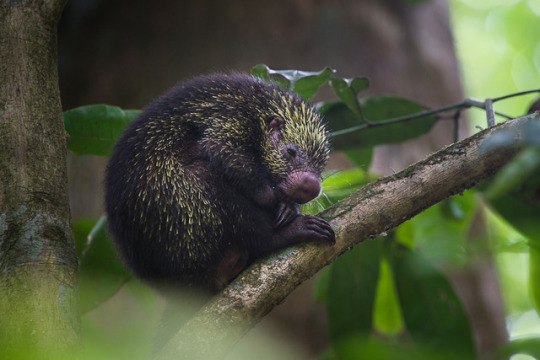

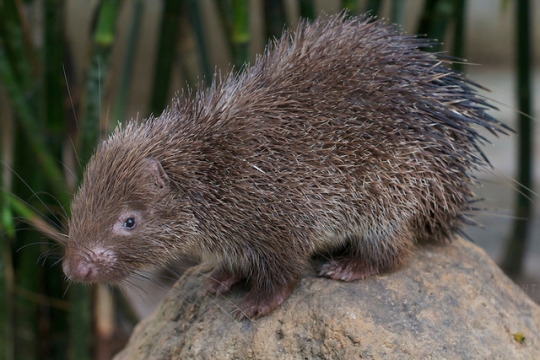


Porcupines are rodents with a coat of sharp spines, or quills, that protect against predators. The term covers two families of animals, the Old World porcupines of family Hystricidae, and the New World porcupines of family Erethizontidae. Both families belong to the infraorder Hystricognathi and display superficially similar coats of quills: despite this, the two groups are distinct from each other and are not closely related to each other. The name "porcupine" comes from Latin porcus pig + spina spine, quill, via Old Italian—Middle French—Middle English. A regional American name for the animal is quill pig.
1. North American Porcupine
2. Baturite Porcupine
3. African Brush-tailed Porcupine
4. Cape Porcupine
5. Prehensile Tailed Porcupine
6. Mexican Hairy Dwarf Porcupine
7. Malayan Porcupine
8. Phlippine Porcupine
9. Stump-tailed Porcupine
10. Bristle-spined Porcupine
Porcupines' quills, or spines, take on various forms, depending on the species, but all are modified hairs coated with thick plates of keratin and embedded in the skin musculature. Quills are released by contact or may drop out when the porcupine shakes its body. New quills grow to replace lost ones. Porcupines were long believed to have the ability to project their quills to a considerable distance at an enemy, but this has since been proven to be untrue.
Porcupines vary in size considerably: Rothschild's porcupine of South America weighs less than 2.2 lbs; the crested porcupine found in Italy, Sicily, North Africa, and sub-Saharan Africa can grow to well over 60 lbs.
The Old World porcupines live in southern Europe, Asia, and most of Africa. They are large, terrestrial, and strictly nocturnal. The New World porcupines are indigenous to North America and northern South America. They live in wooded areas and can climb trees, where some species spend their entire lives. They are less strictly nocturnal than their Old World relatives, and generally smaller.
The 11 Old World porcupines tend to be fairly large, and have spikes grouped in clusters. The two subfamilies of New World porcupines are mostly smaller (although the North American porcupine reaches about 33in in length and 40lb), have their quills attached singly rather than grouped in clusters, and are excellent climbers, spending much of their time in trees. The New World porcupines evolved their spines independently (through convergent evolution) and are more closely related to several other families of rodents than they are to the Old World porcupines.
Defensive behaviour displays in a porcupine depend on sight, scent and sound. Often, displays are shown when a porcupine becomes agitated or annoyed. There are four main displays seen in a porcupine which are quill erection, teeth clattering, emitting of odour, and attack. These displays are ranked from least aggressive to most aggressive respectively.
A porcupine's colouring aids in part of its defense as most of the predators are nocturnal and colour blind. A porcupine's markings are black and white. The dark body and coarse hair of the porcupine are a dark brown/black and when quills are raised, present a white strip down its back mimicking the look of a skunk. This, along with the raising of the sharp quills, deters predators.
Along with the raising of the quills, porcupines clatter their teeth causing warning noise to let predators know not to come closer. The incisors vibrate against each other, the strike zone shifts back and the cheek teeth clatter. This behaviour is often paired with body shivering which is used to further display the dangerous quills. The rattling of quills is aided by the hollow quills at the back end of the porcupine.
The use of odor is when the sight and sound have failed. An invasive scent is produced from the skin above the tail in times of stress, and is often seen with quill erection. If the above processes fail, the porcupine will attack by running sideways or backwards into predators. A porcupines tail is also able to swing in the direction of the predator. If contact is made, the quills could be impaled into the predator causing injury or death.
Porcupines are only occasionally eaten in Western culture, but are very popular in Southeast Asia, particularly Vietnam, where the prominent use of them as a food source has contributed to significant declines in their populations. More commonly, their quills and guardhairs are used for traditional decorative clothing. The main quills may be dyed, and then applied in combination with thread to embellish leather accessories such as knife sheaths and leather bags. Lakota women would harvest the quills for quillwork by throwing a blanket over a porcupine and retrieving the quills it left stuck in the blanket.
#porcupine#quill pig#new world porcupine#old world porcupine#north american porcupine#baturite porcupine#african brush-tailed porcupine#cape porcupine#prehensile tailed porcupine#mexican hairy dwarf porcupine#malayan porcupine#philippine porcupine#stump-tailed porcupine#bristle-spined porcupine#rodents#hystricidae#erethizontidae
84 notes
·
View notes
Photo

Porcospino | Biodiversity Heritage Library | Flickr | Dominio public
1 note
·
View note
Video
Indian Crested Porcupine (Hystrix indica) von Daniel Bauer
Über Flickr:
The Indian Crested Porcupine (Hystrix indica) is a large rodent and inhabited a brode range of biotopes in Southwest and Central Asia (Mammalia: Rodentia: Hystricidae). Heidelberg Zoological Garden
1 note
·
View note
Note
🥝!
hi elle ♥️💓
Fun fact: there are TWO different kinds of porcupines and theyre divided into new world porcupines (Erethizontidae) and old world porcupines (Hystricidae) im not a fan of the name distinction but ! The kinds of porcupines that’re in the Western Hemisphere tend to climb and live in trees, while the kind that lives in Europe/Asia just live on the ground. Also, porcupines are the third largest rodent in the world, after the capybara and beaver
5 notes
·
View notes
Link
"Hystricidae" From Tranquilo Trasciendo by Shinji Wakasa on Dimensions #61.
Thanks to Laima Lisauskienė for this awesome mix!
Tranquilo Trasciendo copies at:
https://rottenmaneditions.bandcamp.com/album/tranquilo-trasciendo
#@rottenmaneditions#@shinjiwakasa#playlist#dimensions#ambientmusic#ambientdrone#newrelease#limitededitions#handmadeprints#handmadeeditions#engravingeditions#vinyls#cds
2 notes
·
View notes
Text
Uncharismatic Fact of the Day
Contrary to popular belief, porcupines can’t throw their quills. However, the foot-long barbs are loosely attached to the porcupine’s skin and will easily become embedded in any animal that comes too close. Over time, any lost quills will be regrown, and a single porcupine may have over 30,000 at a time.

(Image: A North American porcupine (Erethizon dorsatum) by Ashley Conti)
If you like what I do, consider leaving a tip or buying me a ko-fi!
#porcupines#Rodentia#Hystricidae#Erethizontidae#Old World porcupines#New World porcupines#rodents#mammals#uncharismatic facts
162 notes
·
View notes
Text
IDENTIFICATION AND STUDY OF DORSAL GUARD HAIRS OF THE SPECIES BELONGING TO FAMILY-HYSTRICIDAE (Rodentia: Mammalia)
Primary dorsal guard hairs are the most important in hair identification as they exhibit the most specific diagnostic features of the animal. Though large number of tricho-taxonomic studies was carried out by many workers around the world, but meager information on the hairs of the species belonging to the family-Hystricidae is available. From the tricho-taxonomic studies of the hairs and quills of the species under Hystricidae, an identifying key has been prepared on the basis of combination of characters. This study may be helpful to identify the animals from the small parts of skin and quills seized by the enforcement agencies engaged for implementation of wildlife (P) Act, 1972.
Please read full article : - www.mbimph.com
0 notes
Text
PUERCOESPINES PÚAS RÍGIDAS Y ERÉCTILES
PUERCOESPINES PÚAS RÍGIDAS Y ERÉCTILES
LA FAMILIA DE LOS HISTRÍCIDOS ( HYSTRICIDAE ) REÚNE A LOS PUERCOESPINES DEL VIEJO MUNDO, GRUPO DE ROEDORES DE GRANDES DIMENSIONES, CARACTERIZADOS POR UN CUERPO Y UNA COLA CUBIERTOS DE ACÚLEOS RÍGIDOS, ERÉCTILES Y DE LONGITUD VARIABLE, ASÍ COMO POR ROBUSTAS CERDAS FLEXIBLES. ESTAS ÚLTIMAS, EN ALGUNAS ESPECIES,SON PARTICULARMENTE LARGAS EN LA CABEZA Y LOMO, HASTA EL PUNTO QUE CONSTITUYEN AUTÉNTICAS…

View On WordPress
0 notes
Photo

🦔 QUANDU RESGATADO NA ESCOLA ECOPRIME NO KM 5,5 DA ESTRADA DE ALDEIA O animal foi resgatado pela Guarda Ambiental, que após uma breve vistoria constataram que o quandu ou porco espinho tem um ferimento próximo a calda. O animal será encaminhado ao CETAS onde receberá os devidos cuidados. ☎️ 153 ou 3456-7100 Caso encontre algum animal silvestre entre em contato com a Brigada Ambiental O porco-espinho, esse simpático, peculiar e distinto animal é na verdade um roedor (a mesma ordem dos ratos, capivaras e esquilos). O que torna os porco-espinhos (que também podem ser conhecidos no Brasil como ouriço-cacheiro, luís-cacheiro, coandú, cuandú, quandu, ou simplesmente ouriço) tão distintos são seus pelos rígidos e aculeiformes (em formato de agulha). Essa rigidez e formato que fez essa estrutura ser denominada como “espinho”. O porco-espinho, no entanto, não possui somente pelos em forma de espinhos. Em seu dorso há pelagem, porém esta não fica aparente à primeira vista pelo fato de os espinhos cobrirem todo o dorso. Os porcos-espinhos são divididos em duas famílias, os do novo mundo, que pertencem à família Erethizontidae e do velho mundo que pertencem à família Hystricidae. Comportamento São animais solitários, de hábitos noturnos e arborícolas. Costuma usar o solo com relativa frequência e são excelentes nadadores. A cauda preênsil funciona como “quinto membro”, apoiando o corpo enquanto escala árvores ou se movimenta de um galho para o outro. A gestação dura em média 60-70 dias e nasce apenas um filhote. O filhote nasce com alguns espinhos bem pequenos, no entanto, quando filhotes, os pêlos cobrem os espinhos.Os porcos-espinhos são herbívoros, se alimentam de uma grande variedade de frutos, sementes e folhas. https://www.instagram.com/p/CJI-oTDFB9K/?igshid=17b6kx7h65quv
0 notes
Photo



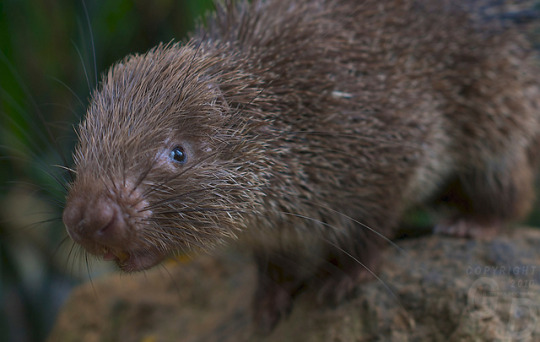


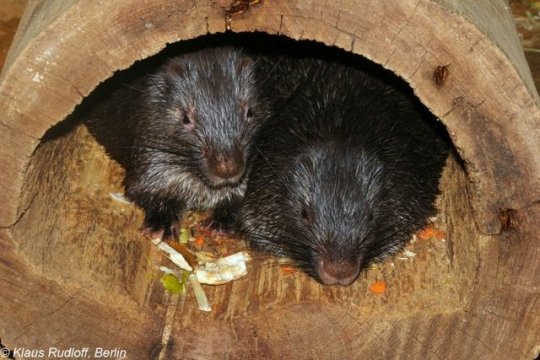
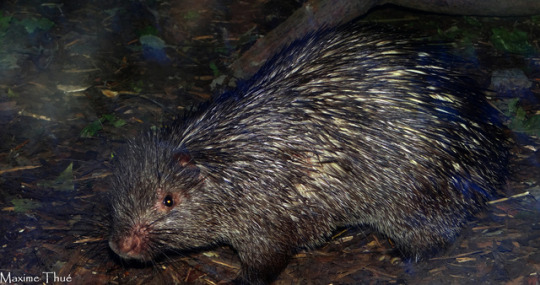

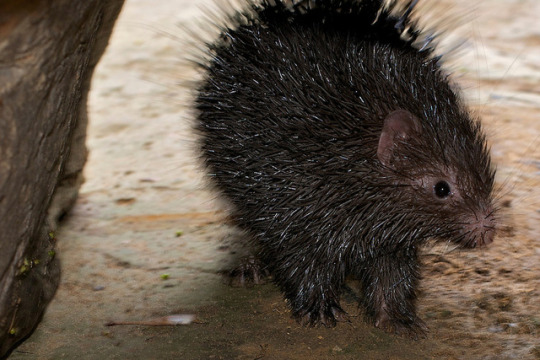
The Philippine porcupine, or Palawan porcupine (Hystrix pumila) is a species of rodent in the family Hystricidae (Old World porcupines) endemic to the island of Palawan in the Philippines. It is known locally as durian or landak. This mammal appears to have no natural enemies. Its outer covering of spines serves as its protection and defense system. It measures about 1.4–3 ft long, not counting a tail of about 1–7.5 inches and weighs 8.4–11.9 lbs.
Apparently, its population is stable, but it is reported to be persecuted by farmers as pests in coconut plantations. Locally common to uncommon, the species is found in primary and secondary forest in the mountains and in the lowlands. This species also inhabits caves, but is commonly found under tree buttresses or in rock crevices. It endemic and restricted to the Palawan Faunal Region. It has been recorded in the islands of Busuanga, Calauit, and Coron, and on the mainland at the Puerto Princesa Subterranean River National Park, and the forested areas of El Nido.
#porcupine#philippine porcupine#palawan porcupine#durian#landak#hystrix pumila#old world porcupines#quill pig
58 notes
·
View notes
Text
Spike the Cape Porcupine

This is Spike. He is a Hystrix africaeaustralis. He is also known as the Cape Porcupines. Cape Porcupines are the largest rodent in South Africa and the largest porcupine in the world!

Domain: Animalia
Phylum: Chordata
Class: Mammalia
Order: Rodentia
Family: Hystricidae

Okay, so all of you real estate agents, take note on this. Spike prefers to live in the rocky hills and he must have shelter during the day. He prefers the savanna or the forest. Usually, he likes caves or ant bear holes. Spikes and his friends are usually found 2000 meters above sea level so, real estate agents get cracking.

Are you single? Are you a porcupine? If so, you have come to the right place. The newest bachelor porcupine, Spike, is nocturnal (but sometimes he does come out in the day) and he is a bit aggressive. He is somewhat solitary and he wants a family of up to six family members. Some of his hobbies are digging through the ground with his claws for roots and he likes to gnaw on bark. He is a (usually) herbivore and he likes to eat fruit and sometimes carrion. Spike is proud to say that he has many other relatives of the porcupine family and he shares a common ancestor with them.

Spikes female friends are really upfront when it comes to intercourse. So, the females make the first move. Spike and his male friends reach their sexual maturity at the age of eight and eighteen months. However, the females reach their sexual maturity between nine and sixteen months. When the females are pregnant they will have litters from one to four newborns. When the babies are born, they will nurse for three to four months. After, about three to four months of nursing, the females cannot conceive children during these three to four months.

So, ladies, real estate agents, start thinking and comment down below if you want to get in touch with Spike!
Fun Facts:
1. Females are one kilogram heavier than males.
2. The spines/quills easily come off when a predator is near.
3. They have very mobile whiskers.
http://animaldiversity.org/accounts/Hystrix_africaeaustralis/
https://www.google.com/search?q=cape+porcupine&oq=cape+p&aqs=chrome.2.69i57j69i59l2j0j69i61j0.2937j1j7&sourceid=chrome&ie=UTF-8
http://www.iucnredlist.org/details/10748/0
https://en.wikipedia.org/wiki/Old_World_porcupine
2 notes
·
View notes
Text
Những điều thú vị về loài nhím có thể bạn chưa biết
Những điều thú vị về loài nhím có thể bạn chưa biết
Nhím (Porcupine) là loài động vật lớn, di chuyển chậm chạp thuộc bộ gặm nhấm với những lông gai sắc nhọn ở đằng sau lưng. Chúng thường sinh sống ở khắp các châu lục, ngoại trừ Nam Cực. Các nhà khoa học chia loài Nhím thành hai nhóm khác nhau: nhím Hystricidae (Old World porcupines) sống ở châu Phi, châu Âu, châu Á và nhím Erethizontidae (New World porcupines) sống ở Bắc Mỹ và Bắc Nam Mỹ. Nhí…
View On WordPress
0 notes